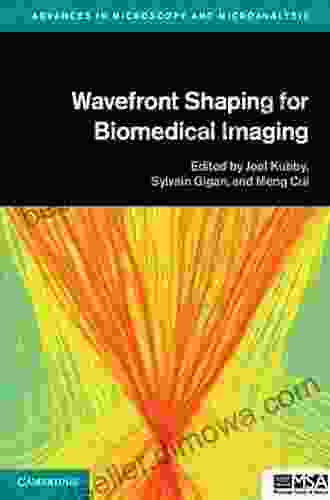Wavefront Shaping for Biomedical Imaging: Advances in Microscopy and Beyond

Wavefront shaping is a powerful optical technique that enables the manipulation and control of light wavefronts. By introducing specific phase distortions to a wavefront, it is possible to focus light in unprecedented ways, overcome limitations of conventional optics, and enhance image quality in various biomedical imaging applications.
5 out of 5
| Language | : | English |
| File size | : | 25285 KB |
| Text-to-Speech | : | Enabled |
| Screen Reader | : | Supported |
| Enhanced typesetting | : | Enabled |
| Print length | : | 444 pages |
This article provides a comprehensive overview of the principles, techniques, and applications of wavefront shaping in biomedical imaging. We will explore how wavefront shaping is revolutionizing microscopy, enabling non-invasive imaging, and opening up new avenues for research and clinical diagnosis.
Principles of Wavefront Shaping
Wavefront shaping is based on the principle of wavefront modulation. A wavefront is a surface of constant phase representing the shape of an electromagnetic wave. By introducing specific phase distortions to a wavefront, it is possible to control the propagation and focusing of light.
Wavefront shaping can be achieved using various methods, including:
- Adaptive optics: Adaptive optics systems use deformable mirrors or spatial light modulators to introduce controlled phase distortions to a wavefront.
- Holography: Holography techniques can be used to record and replay wavefronts, allowing for the manipulation and shaping of light.
- Digital holography: Digital holography combines holography with digital image processing to achieve real-time wavefront shaping.
- Phase masks: Phase masks are optical elements that introduce predetermined phase distortions to a wavefront.
Applications in Microscopy
Wavefront shaping has significantly advanced microscopy techniques, enabling:
- Extended depth of field: Wavefront shaping can be used to increase the depth of field in microscopy, allowing for the imaging of thick specimens without the need for axial scanning.
- Three-dimensional imaging: Wavefront shaping can be used for three-dimensional imaging techniques such as light sheet microscopy and optical projection tomography.
- Super-resolution imaging: Wavefront shaping can be combined with other super-resolution imaging techniques to further enhance image resolution.
- Adaptive optics microscopy: Adaptive optics microscopy uses wavefront shaping to correct for distortions introduced by the sample or the optical system, resulting in improved image quality.
Non-Invasive Imaging
Wavefront shaping has also opened up new possibilities for non-invasive biomedical imaging. By using light as a non-ionizing radiation source, wavefront shaping enables the imaging of biological tissues without causing damage or harm.
- Optical coherence tomography (OCT): OCT combines wavefront shaping with interferometry to achieve high-resolution images of tissue microstructure.
- Photoacoustic imaging: Photoacoustic imaging uses wavefront shaping to enhance image contrast and resolution by converting light-induced acoustic waves into images.
- Endoscopy: Wavefront shaping can be integrated with endoscopy techniques to improve image quality and reduce the need for invasive biopsies.
Other Applications
Beyond microscopy and non-invasive imaging, wavefront shaping has various other applications in biomedical imaging, including:
- Intraoperative imaging: Wavefront shaping can be used to provide real-time guidance during surgical procedures by enhancing image quality and visualization.
- Retinal imaging: Wavefront shaping can be used for non-invasive imaging of the retina, aiding in the diagnosis and monitoring of eye diseases.
- Flow cytometry: Wavefront shaping can be used to manipulate and sort particles in flow cytometry, improving the accuracy and efficiency of cell analysis.
Wavefront shaping is a transformative technology that is revolutionizing biomedical imaging. By enabling the control and manipulation of light wavefronts, wavefront shaping offers a range of benefits in terms of image quality, resolution, and non-invasiveness. As research and development continue, wavefront shaping is expected to play an increasingly important role in advancing biomedical imaging and improving healthcare outcomes.
5 out of 5
| Language | : | English |
| File size | : | 25285 KB |
| Text-to-Speech | : | Enabled |
| Screen Reader | : | Supported |
| Enhanced typesetting | : | Enabled |
| Print length | : | 444 pages |
Do you want to contribute by writing guest posts on this blog?
Please contact us and send us a resume of previous articles that you have written.
 Book
Book Novel
Novel Page
Page Chapter
Chapter Text
Text Story
Story Genre
Genre Reader
Reader Library
Library Paperback
Paperback E-book
E-book Magazine
Magazine Newspaper
Newspaper Paragraph
Paragraph Sentence
Sentence Bookmark
Bookmark Shelf
Shelf Glossary
Glossary Bibliography
Bibliography Foreword
Foreword Preface
Preface Synopsis
Synopsis Annotation
Annotation Footnote
Footnote Manuscript
Manuscript Scroll
Scroll Codex
Codex Tome
Tome Bestseller
Bestseller Classics
Classics Library card
Library card Narrative
Narrative Biography
Biography Autobiography
Autobiography Memoir
Memoir Reference
Reference Encyclopedia
Encyclopedia Blaine Bateman
Blaine Bateman Pedro Luis Rojas Vera
Pedro Luis Rojas Vera Joanne Le Maitre
Joanne Le Maitre Bill Simon
Bill Simon Bartholomew Rommel
Bartholomew Rommel Bob Flowerdew
Bob Flowerdew Mary Caldwell
Mary Caldwell Bill Jacob
Bill Jacob Gary S Cross
Gary S Cross Ben Taylor
Ben Taylor Bhat Boy
Bhat Boy Mario Fachini
Mario Fachini Eliza Graham
Eliza Graham Bob Burke
Bob Burke Katie Aiken Ritter
Katie Aiken Ritter Bob Gibbons
Bob Gibbons Ryan Calais Cameron
Ryan Calais Cameron Becky Wang
Becky Wang Beau Keyte
Beau Keyte Billy Williams
Billy Williams
Light bulbAdvertise smarter! Our strategic ad space ensures maximum exposure. Reserve your spot today!

 Harold BlairUnleash Your Inner Child with "Elementary Imaginings": Poems from the Early...
Harold BlairUnleash Your Inner Child with "Elementary Imaginings": Poems from the Early...
 Ben HayesWhen the Lights Went Out All Over the World: A Literary Odyssey into Darkness...
Ben HayesWhen the Lights Went Out All Over the World: A Literary Odyssey into Darkness...
 George R.R. MartinJourney into a World of Darkness and Redemption: Delve into "The Kidron...
George R.R. MartinJourney into a World of Darkness and Redemption: Delve into "The Kidron... Xavier BellFollow ·10k
Xavier BellFollow ·10k Wesley ReedFollow ·15.1k
Wesley ReedFollow ·15.1k Cole PowellFollow ·13.8k
Cole PowellFollow ·13.8k Craig BlairFollow ·9.5k
Craig BlairFollow ·9.5k Jeff FosterFollow ·12.9k
Jeff FosterFollow ·12.9k Foster HayesFollow ·16.2k
Foster HayesFollow ·16.2k Rubén DaríoFollow ·15.2k
Rubén DaríoFollow ·15.2k Paul ReedFollow ·10.3k
Paul ReedFollow ·10.3k

 Elton Hayes
Elton HayesFly Fishing the Rapid River: A Journey into Angling...
Nestled amidst towering...

 Henry Green
Henry GreenFirst Field Guide to Mushrooms of Southern Africa: Your...
Unveil the Hidden...

 Ben Hayes
Ben HayesWhen the Lights Went Out All Over the World: A Literary...
In the annals of...

 Frank Mitchell
Frank MitchellUnveiling the Secrets of the Impenetrable Forest: My...
An Enchanting...

 Junot Díaz
Junot DíazUp Close: Rachel Carson's Pioneering Legacy
A Woman of Vision and...

 Juan Butler
Juan ButlerUnveiling the Secrets of Turkey's Ancient Sites: A...
Turkey, a land of rich...
5 out of 5
| Language | : | English |
| File size | : | 25285 KB |
| Text-to-Speech | : | Enabled |
| Screen Reader | : | Supported |
| Enhanced typesetting | : | Enabled |
| Print length | : | 444 pages |






